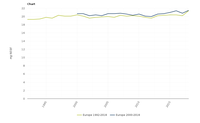
Global mean sea level (GMSL) has risen about 19 cm since 1900, at an accelerating rate. GMSL reached its highest value ever in 2019. Climate models project a GMSL rise during the 21st century that will likely be in the range of 0.29-0.59 m for a low emissions scenario and 0.61-1.10 m for a high one. GMSL projections that include the possibility of faster disintegration of the polar ice sheets predict a rise of up to 2.4 m in 2100 and up to 15 m in 2300. Most coastal regions in Europe have experienced an increase in sea level relative to land, except for the northern Baltic coast.

The total concentration of all greenhouse gases and other forcing agents, including cooling aerosols, reached 457 parts per million CO 2 equivalents in 2018. If this concentration continues to increase at the present decadal rate, concentrations could, in the next few years, exceed the peak level that the Intergovernmental Panel on Climate Change states should not be exceeded if — with a 67 % likelihood — the global temperature increase is to be limited to 1.5 o C above pre-industrial levels by the end of the century. The peak concentrations corresponding to a temperature increase of 2 o C could be exceeded before 2034.


Arctic sea ice is declining rapidly. Since 1979, the Arctic has lost, on average, an area of 79 000 km 2 of sea ice per year in summer and 33 000 km 2 per year in winter. The Arctic summer sea ice area in 2020 was the second lowest ever. Arctic sea ice is also getting younger and thinner. A nearly ice-free Arctic sea in summer is projected to be a rare event for 1.5 °C of global warming but the norm for 2.5 °C of warming. The maximum sea ice extent in the Baltic Sea has shown a decreasing trend since about 1800 and reached its lowest value ever in winter 2019/20. This decreasing trend is projected to continue.

The figure shows the conservation status of habitats at Member State level. Statistics are based on the number of habitat assessments at Member States′ biogeographical/marine level. The number of assessments per Member State is indicated in parentheses. The total number of assessments is 3 246.

Impacts of extreme weather and climate related events in the EEA member countries and the UK.

The figure shows the conservation status of habitats at EU level. Statistics are based on the number of EU habitats assessments (818)

Values show annual life cycle impact potentials for gross electricity generation in the EU-27 for six life cycle impact categories in the period 2005-2018 for a scenario using historic values (actual value) and a counterfactual scenario where the shares of RES are frozen at 2005 levels.

The uptake of electric vehicles in Europe is increasing, in line with the EU’s policy objective of reducing greenhouse gas emissions from transport. However, market penetration remains relatively low. In 2019, electric car registrations were close to 550 000 units, having reached 300 000 units in 2018. This represents an increase from 2 to 3.5 % of total car registrations. The uptake of electric vans also increased, from 0.8 % of total registrations in 2018 to 1.3 % in 2019. Battery electric vehicles, rather than plug-in hybrid, accounted for the majority of electric vehicle registrations in 2019 for cars and vans.

The figure shows the relative change in main global economic and environmental indicators from 1970 to 2018

Country boundaries and transboundary river basins

The map shows European river water bodies with significant pressures from barriers. ‘Significant’ means that the pressure contributes to an impact that may result in failing to meet the WFD objectives of not having at least good status. Each redish line on the map indicates a river water body affected by barriers according to the country-specific assessment system of significant pressures. The map was created from WISE-WFD data reported for the 2nd RBMPs under the WFD (EU-27, and Norway)

The map shows dissolved dissolved inorganic nitrogen (DIN) (NH4 + NO3 + NO2) concentrations in the upper 10 m of the water column, observed in winter of the years 2013-2017.

The map shows mean orthophosphate concentrations in the upper 10 m of the water column, observed in winter of the years 2013-2017.

The map shows total phosphorus concentrations in the upper 10 m of the water column, observed in the years 2013-2017.

• ILUC, indirect land use change.
• The reduction target applies to values that exclude ILUC emissions only.

This dashboard presents detailed information on individual derogations/exceptions, as extracted from the national reports that have been submitted to the European Commission. Click on a derogation to see more information below the table

A derogation/exception is a permit produced by an administration in a EU Member State that allows to deviate from the legal obligation for strict protection of all individuals of
certain species, and of the breeding/resting sites of these individuals, as provided in the EU Birds and Habitats Directives.
This dashboard presents an overview of the derogations and exceptions that national, regional or local administrations have granted across the EU. It is based on the number
of derogations/exceptions that are reported to the EU. Please note that the number of derogations does not reflect the number of individuals affected by the derogations – a
single derogation may cover many individuals, or just a single one

This dashboard presents statistics about the completeness of the information in the national reports on derogations. It shows the percentage of derogations for which mandatory fields of the
reporting form have been filled in.
This dashboard does not provide any assessment of the reported derogations